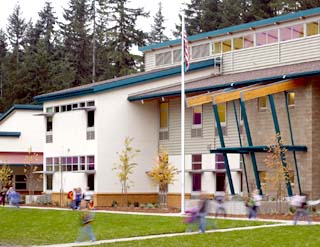
DJC.COM
March 30, 2006
What does a sustainable school cost?
Olympic Associates Co.

Paget
|
Beginning in July 2007, Washington state school districts will be required to implement high-performance, sustainable design standards on virtually all new capital projects and school modernizations.
The supplemental capital budget passed by the 2003 state Legislature charged the state Office of Superintendent of Public Instruction (OSPI) with evaluating the potential for sustainable building practices to reduce school construction spending.
What are the cost implications of implementing high-performance school construction and how will the state benefit?
New design standard

Photo copyright Doug J. Scott
Studies show it's possible to build a green school within the cost range of a conventional school. Cottage Lake Elementary, a green school in Woodinville, cost about 3 percent more to build.
|
OSPI established the Washington Sustainable Schools Program (now called the High-Performance School Buildings Program) in 2003 to prepare a sustainable design standard for K-12 facilities and define incentives for school districts to build facilities that achieve significant benefits over their lifecycle.
The sustainable schools program conducted a pilot study of high-performance design in 2004 with five school districts across Washington and commissioned a study of the costs and benefits of green schools at the national level.
Overall, the studies demonstrated a high potential for significant lifecycle savings and for educational, environmental and social benefits by implementing sustainable building practices.
The findings of these two studies were instrumental in the passage of a 2005 high-performance buildings bill in Washington, requiring state-funded capital projects to achieve either a LEED silver or equivalent rating. The high-performance design standard developed by OSPI, called the Washington Sustainable Schools Protocol, was accepted as the equivalent standard for K-12 school projects.
Sustainability premium
The pilot study conducted by OSPI focused on the estimated initial and lifecycle costs of individual design strategies that fulfill the performance criteria of the protocol.
| Want to learn more? |
|
For more information about the High-Performance School Buildings Program, the Washington Sustainable Schools Protocol and studies from the state Office of Superintendent of Public Instruction, visit www.k12.wa.us/SchFacilities/ HighPerformanceSchoolBuildings.aspx.
The report, “National Review of Green Schools: Costs, Benefits, and Implications for Massachusetts,” is available at http://www.cap-e.com.
For a copy of Steven Paget’s report, “Budgeting for High-Performance Sustainable Schools in Washington State,” e-mail him at spaget@olympicassociates.com. |
The study reported the relative costs of implementing strategies at the different pilot schools and noted the importance of considering costs within their individual context due to the unique nature of each project. Across all pilot schools, more than 50 percent of planned strategies fell into the category "generally cost effective." The policy recommendation of the pilot study was to fund statewide implementation of the protocol.
The study commissioned by OSPI aggregated the results generated by the individual pilot studies and similar cost and benefit data from green school projects nationally.
The study authors applied pilot and national data to a set of performance measures to estimate the economic value of enhanced academic achievement, schools costs and environmental benefits that would accrue from implementing the protocol in Washington.
Drawing upon national cost data for high-performance green buildings, including K-12 facilities, the study used a benchmark value of 2 percent as the premium for sustainable construction. The authors predicted that an initial investment of $5 million would yield a 25-year net return of $7.5 million — a 150 percent return on investment.
A 2005 study commissioned by the Massachusetts Technology Collaborative reviewed national cost data from 30 K-12 schools, including two Washington schools, to determine the financial benefits of high-performance school construction.
The sustainable construction premium of schools within the study ranged from 0 percent to 6.27 percent, with an average of 1.65 percent. Eighteen of the schools had a cost premium of less than two percent and qualified for LEED certified to LEED gold, or equivalent ratings.
When the authors ran a lifecycle cost analysis using a conservative $4-per-square-foot construction cost premium, they estimated the net economic benefit to the state of Massachusetts fell in the range of $60 to $70 per square foot — a 10- to 20-fold return.
Statistical analysis of K-12 school costs in the Northwest indicated that high-performance schools fall into a cost range similar to conventional schools. Costs have run from $125 per square foot to $175 per square foot, with outliers at both ends, but location, market conditions, the site and design choices play as much a role as do high-performance features in determining cost.
In a case study of Cottage Lake Elementary in Woodinville, the cost premium was isolated at 2.8 percent, yet the increase needs to be viewed in the context of this particular project. It is possible to build a green school within the same cost range as conventional schools. Adding two percent to the project budget will enable districts to have greater flexibility and include higher-cost options.
Grants for green design
Following passage of the 2005 high-performance buildings legislation, OSPI reconvened the protocol development committee to incorporate feedback from the pilot study participants. This work is now complete and a final draft of the protocol has been released.
The 2005 Legislature allocated $6.5 million to support the high-performance school buildings program over the current biennium. OSPI recently invited Washington school districts to apply for grant funding to implement the protocol during the 2006 to 2007 voluntary period.
Cost data from voluntary participants and in future years will help refine answers to the cost implications of high-performance school buildings and how the state will benefit.
Steven Paget, senior project manager with Olympic Associates Co., was a coauthor of the Washington Sustainable Schools Pilot Study and now volunteers for the High-Performance School Buildings Implementation Committee.
Other Stories:
- Tips for designing an energy-efficient building
- Toward a sustainable future in South Lake Union
- Historic preservation projects can be green
- Low-impact development gets a test in Renton
- Smart lighting design: go for timeless, not trendy
- Brownfield project demonstrates Seattle's creative know-how
- 3 advances show the future of site development
Copyright ©2009 Seattle Daily Journal and DJC.COM.
Comments? Questions? Contact us.